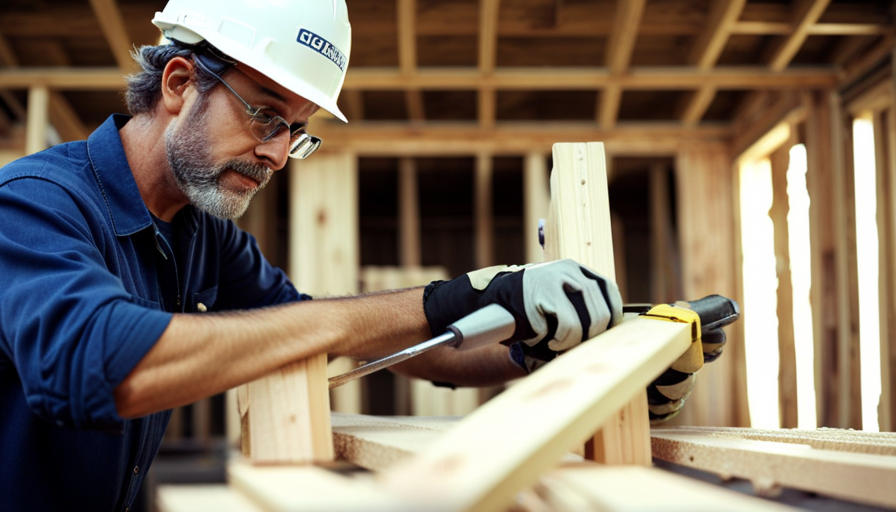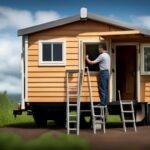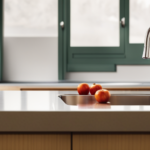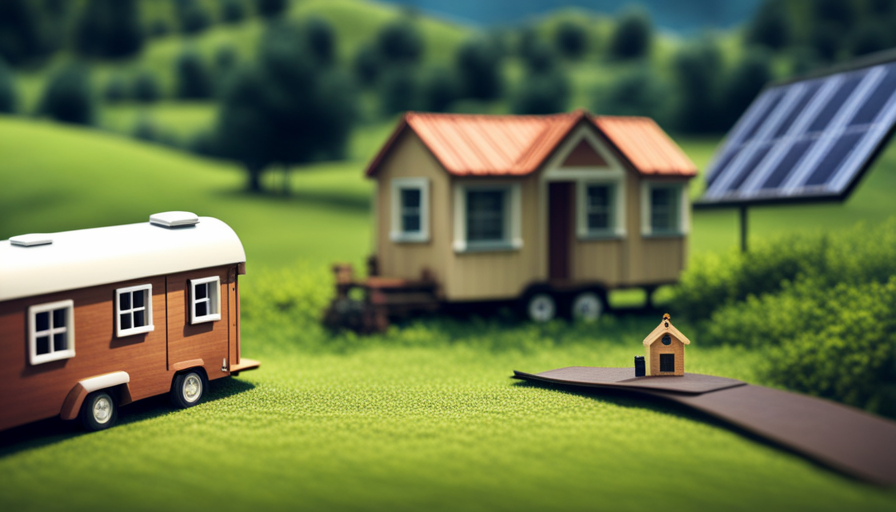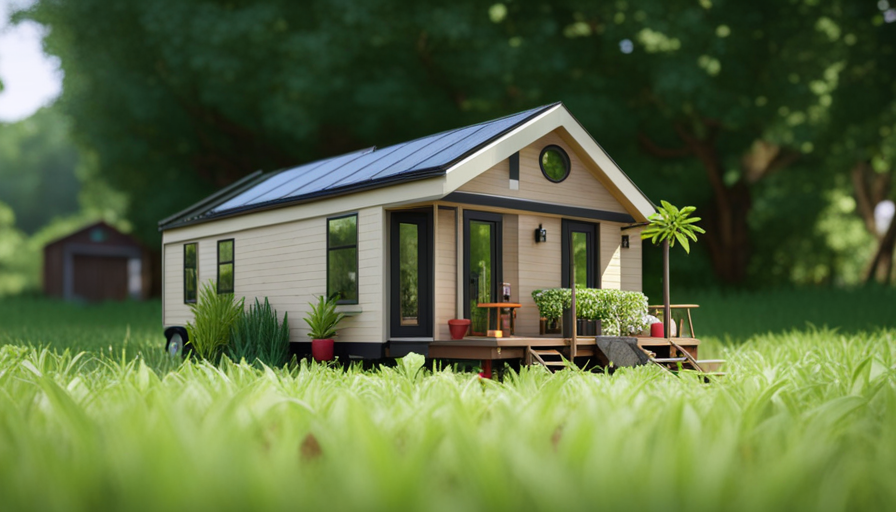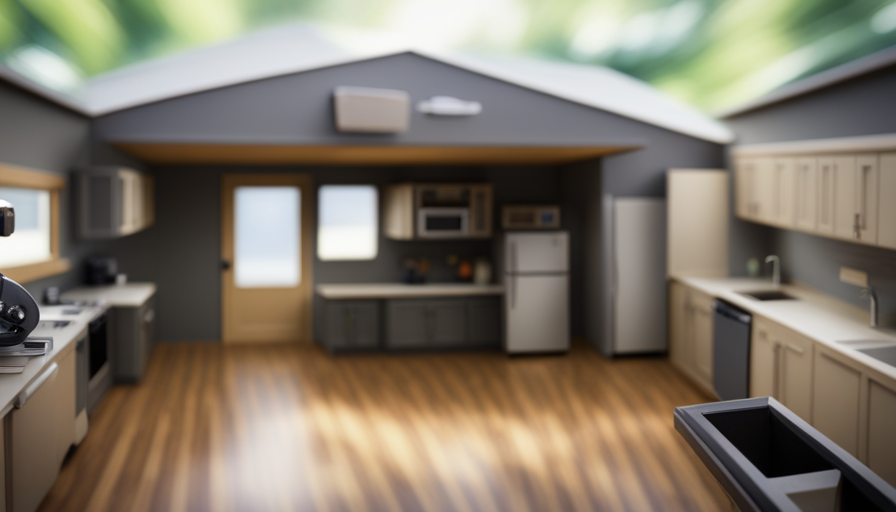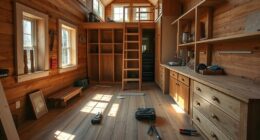Water, essential for life, permeates every part of our everyday existence. It satisfies our thirst, purifies our bodies, and feeds the planet. However, what occurs when you opt for a more minimalist and eco-friendly way of living in a mobile tiny home? How is water managed in this distinctive dwelling, where there’s a scarcity of room yet an unchanging demand for this vital element?
In this article, I will delve into the intricacies of water management in a tiny house on wheels. From sourcing water to filtration and treatment, plumbing systems to greywater and blackwater management, I will explore every aspect of this essential system. Along the way, I will provide valuable tips for water conservation in the tiny living space, as well as strategies for winterization and freeze protection.
So, join me on this journey as we unravel the wonders of water in the world of tiny house living. Let’s dive in and discover how to make every drop count in our mobile sanctuaries.
Key Takeaways
- Water storage options in a tiny house on wheels include freshwater tanks and rainwater harvesting.
- Proper filtration and treatment of rainwater is necessary to make it safe for consumption.
- Plumbing systems in a tiny house on wheels require careful consideration and the installation of water lines and pipes.
- Managing water pressure is essential for maintaining a consistent water supply, and using a pressure regulator can help achieve this.
Understanding the Water Needs of a Tiny House on Wheels
You’ll be amazed by the efficient water system in a tiny house on wheels and how it meets your unique needs while still providing all the comforts of home.
When it comes to water storage options, there are a few key considerations for tiny houses on wheels. One popular choice is to have a freshwater tank installed underneath the house. These tanks can hold anywhere from 20 to 60 gallons of water, depending on the size of the house.
Another option is to utilize rainwater harvesting. This involves collecting rainwater from the roof and storing it in a separate tank. Rainwater harvesting not only reduces reliance on freshwater sources but also is a sustainable and environmentally friendly solution.
Many tiny houses on wheels are equipped with a filtration system to ensure that the water is safe to use and drink. This system typically includes a series of filters that remove impurities and bacteria. Once the water is filtered, it can be used for various purposes such as showering, cooking, and cleaning.
Transitioning into the subsequent section, sourcing water for a tiny house on wheels involves careful planning and consideration.
Sourcing Water for a Tiny House on Wheels
Finding a reliable water source can be a challenging and crucial aspect to consider when living in a mobile, compact home. In a tiny house on wheels, there are two main options for sourcing water: rainwater collection and connecting to an external water source.
Rainwater Collection:
- Installing a rainwater collection system allows you to harness the power of nature and collect rainwater for your water needs. This involves setting up gutters and downspouts to direct rainwater into a storage tank.
- To ensure the collected rainwater is safe for use, it’s essential to filter and treat it properly. This can be done through a combination of physical and chemical filtration methods.
Connecting to an External Water Source:
- Another option is to connect your tiny house on wheels to an external water source, such as a municipal water supply or a well. This requires plumbing connections and a water hose to bring water into your home.
- It’s important to have a proper water hookup system in place to ensure a reliable and consistent water supply.
Transitioning into the next section about water filtration and treatment, it’s crucial to address the importance of filtering and treating the water obtained from either rainwater collection or an external source for safe consumption.
Water Filtration and Treatment
When it comes to water filtration in a tiny house on wheels, choosing the right system is crucial. With limited space and resources, it’s important to select a filtration system that not only fits within the dimensions of the tiny house but also effectively removes contaminants.
Additionally, treating water for safe consumption is essential to ensure the health and well-being of the occupants. This involves using methods such as UV sterilization, carbon filters, and reverse osmosis to remove bacteria, viruses, chemicals, and other impurities from the water source.
Choosing the Right Filtration System
Selecting the appropriate filtration system is crucial to ensure clean and safe water in a tiny house on wheels. When comparing different water filtration options, it’s important to consider factors such as filtration capacity, maintenance requirements, and the level of contaminants they can remove.
One option to consider is a carbon filter, which effectively removes chlorine, sediment, and organic compounds. Another option is a reverse osmosis system, which uses a membrane to remove impurities, including bacteria and viruses. Additionally, UV filters can be used to kill microorganisms present in the water.
It’s essential to select a filtration system that meets your specific needs and the quality of the water source. By choosing the best filtration system, you can ensure that your water is clean and safe for consumption.
Now let’s explore how to treat water for safe consumption.
Treating Water for Safe Consumption
To ensure your water is safe to drink in your mobile home, it’s time to explore how you can treat it for consumption. Here are three water purification methods you can consider:
-
Boiling: This is a simple and effective method where you bring the water to a rolling boil for at least one minute to kill any harmful bacteria or parasites.
-
Chemical disinfection: Using chlorine tablets or iodine drops can help disinfect the water by killing bacteria and viruses. Follow the instructions provided to ensure proper dosage and contact time.
-
Filtration systems: Installing a water filtration system can remove impurities and improve water quality. Look for systems that can effectively remove bacteria, viruses, and other contaminants.
Before implementing any treatment method, it’s crucial to test the water quality regularly. This can be done using water testing kits, which measure parameters such as pH, turbidity, and the presence of harmful substances. By ensuring your water is properly treated and tested, you can enjoy clean and safe drinking water in your tiny house on wheels.
Now, let’s delve into the plumbing systems in a tiny house on wheels.
Plumbing Systems in a Tiny House on Wheels
When it comes to plumbing systems in a tiny house on wheels, there are three key points to consider.
First, choosing the right plumbing fixtures is crucial to ensure functionality and space efficiency.
Second, installing water lines and pipes requires careful planning and expertise to avoid leaks and maximize space utilization.
Lastly, managing water pressure is essential to ensure a consistent and reliable water supply while on the move.
These three aspects of plumbing are vital for a well-designed and functional tiny house on wheels.
Choosing the Right Plumbing Fixtures
Opt for the appropriate plumbing fixtures to ensure seamless water functionality in your tiny house on wheels. Here are four key considerations for water fixture selection and installation:
-
Size and Space: Choose fixtures that fit well within the limited space of a tiny house. Compact options, such as small sinks and low-profile toilets, can maximize functionality while saving space.
-
Water Efficiency: Prioritize fixtures with high water efficiency ratings. Look for low-flow faucets, showerheads, and toilets that conserve water without compromising performance.
-
Durability: Invest in fixtures made from durable materials that can withstand the vibrations and movement associated with a mobile tiny house. Stainless steel or brass fixtures are excellent choices for their longevity.
-
Ease of Installation: Opt for fixtures that are easy to install and maintain. Consider choosing fixtures that come with clear installation instructions and are compatible with the plumbing system in your tiny house.
By carefully selecting and installing the right plumbing fixtures, you can ensure a well-functioning water system in your tiny house on wheels. Now let’s delve into the next section about installing water lines and pipes.
Installing Water Lines and Pipes
Get ready to tackle the exciting task of installing the water lines and pipes in your tiny mobile home, because it’s time to bring the plumbing to life!
When it comes to water line installation, there are a few important factors to consider. Firstly, you need to choose the right pipe materials. Copper pipes are a popular choice due to their durability and resistance to corrosion. PEX (cross-linked polyethylene) pipes are another option that’s flexible and easy to work with.
Once you’ve chosen the pipe materials, it’s time to start the installation process. This involves measuring and cutting the pipes to the appropriate lengths, as well as connecting them with fittings. Remember to use proper tools and techniques to ensure a secure and leak-free installation.
With the water lines and pipes in place, you can now move on to managing water pressure and ensuring a steady flow of water throughout your tiny house.
Managing Water Pressure
To ensure a steady flow of water in your tiny mobile home, it’s crucial that you properly manage the water pressure. Water pressure management is essential for optimizing water flow and preventing issues such as leaks, bursts, or inadequate water supply. One effective way to manage water pressure is by using a pressure regulator. This device helps to control the incoming water pressure and maintain it at a safe and consistent level. It is typically installed at the main water inlet and can be adjusted to meet the specific needs of your tiny house. By regulating the water pressure, you can prevent damage to your plumbing system and ensure a reliable supply of water. Furthermore, it is important to regularly inspect and maintain the pressure regulator to ensure its proper functioning. With proper water pressure management in place, you can now move on to the next section, which focuses on greywater and blackwater management.
Greywater and Blackwater Management
Start by creating a system for managing greywater and blackwater in your tiny house on wheels, ensuring that you’re effectively handling approximately 80 gallons of wastewater per week, equivalent to the amount of water in two standard bathtubs.
Greywater recycling is an efficient way to reduce water usage in your tiny house. By diverting water from sources such as sinks, showers, and washing machines, you can reuse it for non-potable purposes like watering plants or flushing toilets. Installing a greywater filtration system will remove impurities and make the water safe for these applications.
Additionally, composting toilets are an excellent alternative to traditional flush toilets in tiny houses. These toilets use little to no water and turn waste into compost, reducing the amount of blackwater generated.
Properly managing both greywater and blackwater is essential to maintain a sustainable and eco-friendly lifestyle in your tiny house on wheels.
Transitioning into the subsequent section about energy-efficient water heating, it’s important to consider the impact of water usage on your overall energy consumption.
Energy-Efficient Water Heating
Maximize your energy savings with an energy-efficient water heating system in your tiny house on wheels. When it comes to heating water in a small space, every bit of energy saved counts.
By implementing energy-efficient water heating techniques, you can reduce your environmental footprint and save money on utility bills. One effective method is to use a tankless water heater, which heats water on demand instead of constantly maintaining a tank of hot water. This eliminates the standby energy loss associated with traditional water heaters.
Additionally, insulating the hot water pipes helps to minimize heat loss during distribution.
Another energy-saving technique is to install a solar water heater. These systems use the sun’s energy to heat water, reducing reliance on electricity or gas. By harnessing the power of renewable energy, you can heat your water without contributing to greenhouse gas emissions.
Incorporating water-saving techniques such as low-flow faucets, showerheads, and toilets can also contribute to energy efficiency. These fixtures reduce water consumption without sacrificing performance.
Transitioning into the subsequent section about water conservation tips for tiny living, it’s important to consider not only energy-efficient water heating but also other ways to conserve water in your tiny house on wheels.
Water Conservation Tips for Tiny Living
When it comes to water conservation in tiny living, two key points to consider are implementing low-flow fixtures and practicing water-saving habits.
Low-flow fixtures, such as low-flow showerheads and faucets, can significantly reduce water usage without sacrificing water pressure. By using these fixtures, I can save water and reduce my environmental impact.
Additionally, practicing water-saving habits like turning off the tap while brushing my teeth or collecting rainwater for gardening can further contribute to water conservation in my tiny home.
Implementing Low-Flow Fixtures
To conserve water in your tiny house on wheels, you can easily install low-flow fixtures that’ll help you save gallons of water with just a drop. Low-flow fixtures have numerous benefits when it comes to water conservation. They reduce water consumption by limiting the amount of water that flows through the fixture, saving water and lowering your water bill. Additionally, low-flow fixtures contribute to environmental sustainability by reducing the strain on water resources. By using less water, you’re helping to conserve this precious resource.
Installing low-flow fixtures is a simple and effective way to practice water-saving techniques in your tiny house on wheels. By incorporating these fixtures, you can significantly reduce your water usage and contribute to a more sustainable lifestyle. Transitioning into the next section about practicing water-saving habits, it’s important to remember that conservation goes beyond just installing fixtures.
Practicing Water-Saving Habits
Embrace the opportunity to make a positive impact by incorporating water-saving habits into your daily routine. By practicing water-saving techniques, you can significantly reduce your water consumption in a tiny house on wheels.
Here are two sub-lists of habits that can help you achieve this:
-
Indoor Water-Saving Habits:
- Install low-flow fixtures such as aerators and showerheads to reduce water flow without compromising water pressure.
- Fix any leaks promptly to prevent unnecessary water wastage.
-
Outdoor Water-Saving Habits:
- Collect rainwater in barrels or tanks to use for irrigation.
- Plant native and drought-tolerant vegetation to minimize the need for watering.
By adopting these habits, you can conserve water and ensure its responsible use.
Transitioning into the next section about winterization and freeze protection, it’s crucial to prepare your tiny house for the colder months.
Winterization and Freeze Protection
In order to prevent freezing during the winter months, you should insulate your tiny house’s plumbing system and use a heat tape or pipe heater to maintain a minimum temperature of 40°F (4°C) in the water lines. Pipe insulation is crucial in protecting your water lines from freezing. It acts as a barrier, reducing heat loss and preventing the water from reaching freezing temperatures. Insulating materials such as foam sleeves or fiberglass wraps can be easily installed around the pipes to provide the necessary protection.
To further safeguard your water system, consider using a heat tape or pipe heater. These devices are designed to provide controlled heat to the pipes, ensuring that the water inside remains above freezing temperature. Heat tapes are flexible, electrical heating elements that can be wrapped around the pipes, while pipe heaters are installed directly onto the pipes.
To illustrate the importance of winterization and freeze protection, here is a table showcasing the benefits of pipe insulation and the use of a heat tape or pipe heater:
| Benefit | Pipe Insulation | Heat Tape or Pipe Heater |
|---|---|---|
| Prevents freezing | ✅ | ✅ |
| Reduces heat loss | ✅ | |
| Facilitates thawing | ✅ | |
| Protects against damage | ✅ |
By winterizing your tiny house’s water system through pipe insulation and the use of a heat tape or pipe heater, you can ensure that your water lines remain functional and free from freezing. This will minimize the risk of damage and the need for thawing frozen pipes. Moving on to the next section about maintenance and troubleshooting, it is important to continue implementing preventive measures to keep your water system in optimal condition.
Maintenance and Troubleshooting
When it comes to maintaining and troubleshooting the water system in my tiny house on wheels, regular inspections and cleaning are key.
I make sure to inspect all the components of my water system, such as the water tank, pipes, and faucets, on a regular basis to ensure they’re in good working condition.
Additionally, I make it a point to clean my water system regularly to prevent any build-up or contamination that could lead to issues down the line.
If I do encounter any common water system issues, such as leaks or low water pressure, I’m equipped with the knowledge and solutions to address them promptly and effectively.
Regular Inspections and Cleaning
Maintain a clean and efficient water system in your tiny house on wheels by regularly inspecting and cleaning it. This ensures that your water supply remains safe and reliable. Here are five important tasks to include in your regular maintenance routine:
-
Inspect all water lines for leaks or damage. Use a flashlight to check for any signs of water leakage and address them promptly.
-
Clean the water tanks and filters regularly to prevent the buildup of debris and contaminants. Flush the tanks and replace the filters as needed.
-
Test the water quality regularly to ensure it meets safety standards. Use water testing kits to check for any potential issues.
-
Check the water pump and pressure system for proper functioning. Ensure that the pressure is consistent and the pump is working efficiently.
-
Inspect the plumbing fixtures and connections for any signs of wear and tear. Replace or repair any damaged parts to prevent leaks.
By following these regular maintenance tasks, you can keep your water system in optimal condition and prevent common water system issues and solutions.
Common Water System Issues and Solutions
Addressing common water system issues is crucial for ensuring a safe and reliable water supply in your tiny home on wheels, so let’s dive into some practical solutions. Proper water system maintenance is essential to prevent any potential problems. Regularly inspecting for leaks, loose connections, and damaged pipes can help identify issues early on. Troubleshooting water leaks can be done by checking for damp spots, water stains, or a decrease in water pressure. Once a leak is detected, it is important to promptly repair or replace any damaged components. Additionally, ensuring that all fittings and connections are tight and secure can prevent leaks from occurring. A table summarizing common water system issues, their causes, and solutions can be found below:
| Issue | Cause | Solution |
|---|---|---|
| Low water pressure | Clogged pipes | Clean or replace filters |
| Strange odor/taste | Contaminated water | Install a water filter |
| Water leaks | Loose connections | Tighten fittings |
| Burst pipes | Freezing temperatures | Insulate pipes |
| Water pump not working | Electrical malfunction | Check wiring and connections |
By addressing these common water system issues and implementing the appropriate solutions, you can ensure a reliable water supply in your tiny home on wheels. For more resources and further reading on maintaining and troubleshooting water systems, refer to the subsequent section.
Resources and Further Reading
For more information on how water works in a tiny house on wheels, check out these helpful resources and further reading.
When it comes to water storage options in a tiny house on wheels, there are a few key considerations to keep in mind. One popular option is using a gravity-fed water system, which relies on storing water in tanks located under the floor or in a separate compartment. This allows for easy access to water without the need for electricity or pumps.
Another option is rainwater harvesting, which involves collecting rainwater from the roof and storing it in a tank for later use. This can be a sustainable and cost-effective way to supply water for various needs. However, it’s important to ensure proper filtration and treatment of the collected rainwater to make it safe for consumption.
There are numerous resources available that provide detailed information on water storage options and rainwater harvesting techniques for tiny houses on wheels. These resources can offer valuable insights and guidance for anyone looking to implement a reliable and efficient water system in their tiny home.
Frequently Asked Questions
What are the best ways to conserve water in a tiny house on wheels?
To conserve water in a tiny house on wheels, there are several helpful tips to follow. Firstly, consider installing low-flow fixtures such as showerheads and faucets to reduce water usage.
Additionally, insulate your water pipes to prevent heat loss and minimize the need for hot water.
Utilize a composting toilet system to reduce water consumption.
For water storage options, consider installing a rainwater harvesting system or using portable water tanks that can be refilled as needed.
How do you handle waste water management in a tiny house on wheels?
When it comes to waste water management in a tiny house on wheels, efficiency is key. To ensure water conservation, I employ various methods.
Firstly, I use a composting toilet that separates solid waste from liquid waste, reducing water usage.
Additionally, I have a greywater system in place, which collects and filters water from sinks and showers for reuse in irrigation.
By implementing these waste water management strategies, I minimize my environmental impact while living comfortably on the road.
What are some energy-efficient options for heating water in a tiny house on wheels?
When it comes to energy-efficient options for heating water in a tiny house on wheels, compact water heaters are the way to go. These innovative devices are designed to provide hot water while consuming minimal energy.
Some popular options include tankless water heaters, heat pump water heaters, and solar water heaters. These compact units are specifically designed for small spaces, making them ideal for tiny houses on wheels where space is limited.
By using these energy-efficient heating options, you can enjoy hot water without compromising on sustainability.
Are there any specific maintenance or troubleshooting tips for the water systems in a tiny house on wheels?
For maintenance tips in a tiny house on wheels’ water system, regular inspection is key. Check for leaks, loose connections, or damaged pipes. Clean water filters and replace them as needed.
To prevent freezing in colder climates, insulate pipes and use heat tape. Troubleshooting techniques include checking the water pump for proper functioning, testing the water pressure, and ensuring the water heater is working correctly.
Additionally, regularly sanitizing the water storage tanks will help maintain water quality.
Where can I find additional resources and further reading on water systems in tiny houses on wheels?
Looking for additional resources and further reading on water systems in tiny houses on wheels?
There are plenty of online platforms and books that delve into this topic.
Websites like Tiny House Community and Tiny House Magazine offer articles and forums where you can find valuable information.
Additionally, books like ‘The Tiny House Handbook’ by Ryan Mitchell and ‘Tiny House Systems Demystified’ by Chris Haynes provide in-depth explanations and insights on water systems in tiny houses on wheels.
Conclusion
In conclusion, managing water in a tiny house on wheels requires careful planning and maintenance. One interesting statistic to note is that a typical tiny house on wheels uses only about 10% of the water consumed by an average American household. This highlights the importance of water conservation in this unique living arrangement.
By sourcing water efficiently, implementing effective filtration and treatment systems, and properly managing greywater and blackwater, tiny house dwellers can enjoy a sustainable and comfortable water supply. Regular maintenance and winterization measures are also crucial to ensure a hassle-free water system in a tiny house on wheels.
Hi, I’m Emma. I’m the Editor in Chief of Tiny House 43, a blog all about tiny houses. While tree houses are often associated with childhood, they can be the perfect adult retreat. They offer a cozy space to relax and unwind, surrounded by nature. And since they’re typically built on stilts or raised platforms, they offer stunning views that traditional homes simply can’t match. If you’re looking for a unique and romantic getaway, a tree house tiny house might just be the perfect option.

